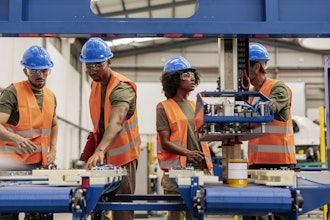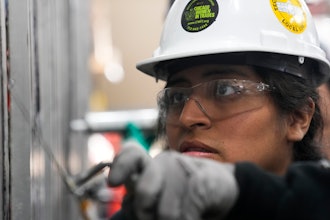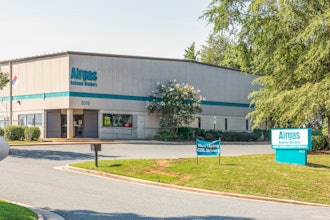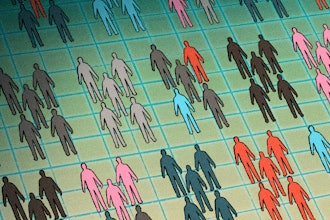
Staffing shortages are far from unique to the wholesale distribution business. What is unique, though, is that the talent crunch has arrived at a moment when various forms of automation appear poised to change both the scope and the nature of this industry’s talent base.
If the historical ebbs and flows of the global economy are any guide, today’s tight labor market will at some point loosen. There’s no reason to believe, though, that the progressive digitalization and automation of industrial distribution we’ve observed over the past decade will slow. Machine learning and other technological advances will continue to propel the capabilities of robotics and cobotics, augmented reality (AR), and a bevy of other emerging enablers (digital order capture, autonomous drones and trucks, warehouse execution systems, mobile robotic sortation systems, the list goes on). What are the implications for the industry and its labor force?
Let’s answer that within the framework of four key strategic priorities for industrial distributors as they adapt to evolving economic realities: offering high-value services; delivering anything, anywhere, anytime; providing end-to-end customer solutions; and optimizing business operations.
To set the table, here are brief descriptions of each:
Offering high-value services: Distributors can no longer survive on simply breaking bulk and carrying a standard catalog of products. They must wrap services – light manufacturing, kitting, and product consulting being examples – around those products to differentiate themselves from online competitors.
Delivering anything, anywhere, anytime: Distribution has always been a customer-focused business. Those customers now want more and more products, delivered faster, via a wider variety of touchpoints, and to more diverse destinations.
Providing end-to-end customer solutions: Distributors must establish themselves as trusted partners through close collaboration with customers on larger projects. The goal is to become more than a product supplier by delivering product-service bundles such as commercial project management including on-time delivery of materials; hiring of third-party contractors where necessary; and, if customers so choose, the option for ongoing maintenance after a successful delivery; and extended supply-chain visibility for carbon-accounting or other needs.
Optimize business operations: Delivering on the above will hinge on harnessing intelligent technologies and automation that streamline communication within your organization and beyond its walls, cut back on manual labor and impromptu workarounds resulting from outdated processes, and speed up delivery time. This strategic priority plays directly into the work lives of your team members, who are, ideally, empowered to focus on more interesting and engaging challenges (and feel more valued as a result).
The broader, long-term impact of all this on staffing will be a mixed bag. The technological ingredients to whip up a “dark warehouse” (that is, one that, lacking human workers entirely, needs no lighting) are largely at hand already. But the ultimate manifestations of vision, inasmuch as they’re truly worth pursuing, remain to be seen. Still, digitalization and automation will surely reduce headcounts. Some years back, a Citi/University of Oxford study suggested that 65.7% of wholesale-trade jobs and 75% of transportation-and-warehousing jobs would ultimately be automated. (It may be cold comfort, but that study also projected that 47% of all jobs would one day be automated).
Given the millions of warehouse and fulfillment workers in the United States alone and the heightened political profile those workers have gained in recent years, there will surely be fallout here and, perhaps particularly, abroad, where workers’ rights are more deeply ingrained.
Yet there’s a bright side that extends beyond the bottom line of staying competitive through the continually improving customer service that digitalization and automation foster. This industry will continue to provide jobs. Some will still be on the warehouse floor, using AR and other tools to provide computational, perceptive, and mechanical boosts to the unsurpassed (at least for the foreseeable future) power of the human mind. By and large, they’ll be less repetitive and more interesting jobs than they are today: jobs that staff will view as having purpose; jobs that provide opportunities for continual learning and professional and personal growth; jobs that boost employee retention.
This shift in the makeup of staffing – largely one in which predominantly manual labor is to a degree augmented, but also supplanted by the work of specialized knowledge workers – presents another challenge for the industry. Let’s be honest: Industrial distribution’s attractiveness from the perspective of, say, a data scientist versed in the latest artificial intelligence and machine learning techniques, is more or less inversely proportional to the industry’s economic and societal importance. This industry lacks brand recognition among the sort of talent that its future depends on. How many college and community-college students considering their next career steps are aware that McKesson and AmerisourceBergen are the ninth and 10th largest corporations in America in terms of revenue – just below Google-parent Alphabet and just above Microsoft? Yet where do you suppose they’re more likely to apply for a job?
To make real progress toward those four strategic priorities, distributors should:
- Impress upon a generation that’s as interested in working for personal fulfillment and societal benefit as it is in amassing direct deposits that industrial distribution is economically vital and technologically and commercially diverse, vibrant, and evolving fast.
- Engage with community colleges and universities (such as the Texas A&M’s Industrial Distribution program, where I teach as an adjunct) and clear paths for internships, work-study, and early career opportunities to hook the best and brightest.
- Consider the capabilities of team members they already employ and upskill those with the potential and interest in leveraging their nuts-and-bolts understanding of the business into higher-level, more cognitively demanding – and fulfilling – work.
Doing so will not just help attract and retain the sort of workforce the distribution business needs going forward. The influx and reshaping of talent will also speed the industry’s evolution from one providing increasingly commoditized product storage and transport to one that brims with creative value-added services that bring an ever-broadening array of solutions to customers who truly value them.
Magnus Meier is the global VP for wholesale distribution at SAP and a senior lecturer in the Master of Industrial Distribution program at Texas A&M.






















